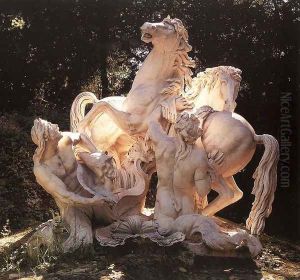Gaspard Marsy Paintings
Gaspard Marsy was a prominent French sculptor who played a significant role in the development of Baroque sculpture in France during the 17th century. Born in 1624 in Cambrai, which was then part of the Spanish Netherlands, Marsy was part of a family of artists, which helped pave the way for his future career in the arts. His early life was marked by an immersion in the artistic environment, thanks to his family's background, which undoubtedly influenced his decision to pursue sculpture as his life's work.
Marsy moved to France, where he became deeply involved in the bustling artistic scene. He was particularly known for his collaboration with his brother, Balthazar Marsy, also a talented sculptor. Together, they contributed significantly to the decoration of the Palace of Versailles, one of their most notable commissions from King Louis XIV. This work included the creation of several sculptures and fountains that still stand as testament to their skill and creativity, contributing to the grandeur and beauty of Versailles.
Throughout his career, Gaspard Marsy was celebrated for his ability to blend strength and delicacy in his sculptures, capturing the essence of his subjects with remarkable vitality and expression. His work was characterized by a dynamic use of form and a masterful handling of materials, qualities that made his sculptures stand out in the era of Baroque art.
Marsy's contributions to French sculpture were not limited to Versailles. He worked on numerous other projects and commissions that showcased his versatility and skill in handling different themes and materials. His influence extended beyond his lifetime, as his approach to sculpture influenced subsequent generations of artists, contributing to the evolution of French art.
Gaspard Marsy passed away in 1681, leaving behind a legacy that has endured through the centuries. His work remains celebrated for its artistic excellence and its significant role in the enhancement of French Baroque sculpture. Marsy's sculptures continue to be admired for their emotional depth, technical mastery, and their contribution to the splendor of France's artistic heritage.
